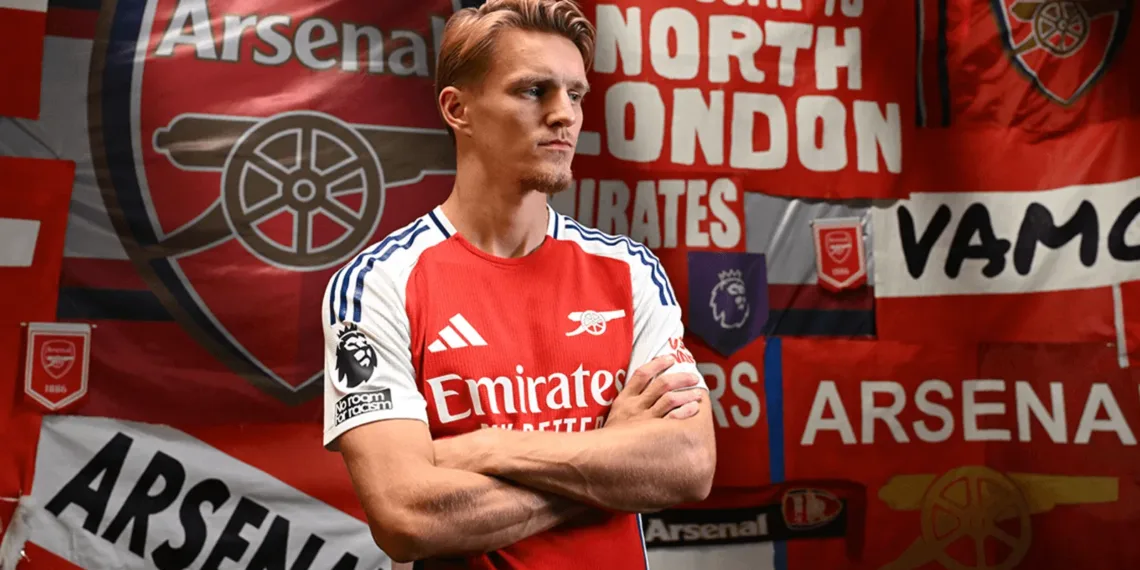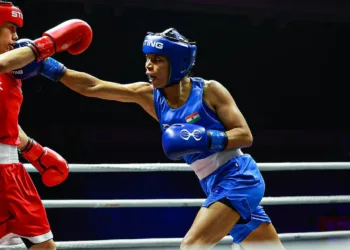Arsenal’s lackluster attacking performance in their defeat to Inter on Wednesday night exposed several of the team’s ongoing issues. The return of Martin Ødegaard can’t come soon enough to provide a much-needed boost.
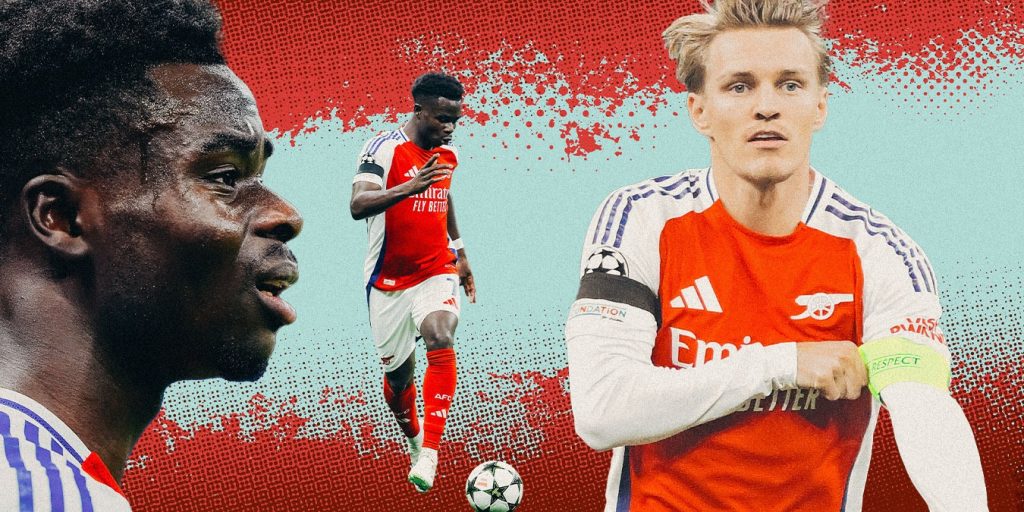
Table of Contents
Bukayo Saka: Arsenal’s Key Man Facing Growing Burden
Being overly dependent on a player like Bukayo Saka is a problem that many clubs would be eager to have. However, for an injury-plagued Arsenal, this reliance on their star player is beginning to show its toll.
With Ødegaard sidelined and other forwards like Gabriel Martinelli, Kai Havertz, and Leandro Trossard struggling for form, Arsenal has become even more dependent on Saka. Unfortunately, both he and the team are feeling the pressure.
After picking up an injury during England’s UEFA Nations League match against Greece last month, Saka missed two games for Arsenal: a 2-0 loss to Bournemouth and a narrow 1-0 win over Shakhtar Donetsk in the Champions League.
Since then, Saka has played nearly every minute of the subsequent matches, including a 28-minute appearance against Preston in the EFL Cup.
Manager Mikel Arteta has often spoken about his expectations for Saka, emphasizing that the best players in the world manage to play 70 games a season and still make a difference. Arteta clearly expects no less from Saka, whose performances have lived up to such high standards.
This season, in just nine Premier League games, Saka has already contributed three goals and seven assists, with only Cole Palmer, Mohamed Salah (both with 12), and Erling Haaland (11) recording more goal involvements, none of whom have dealt with injury this season.
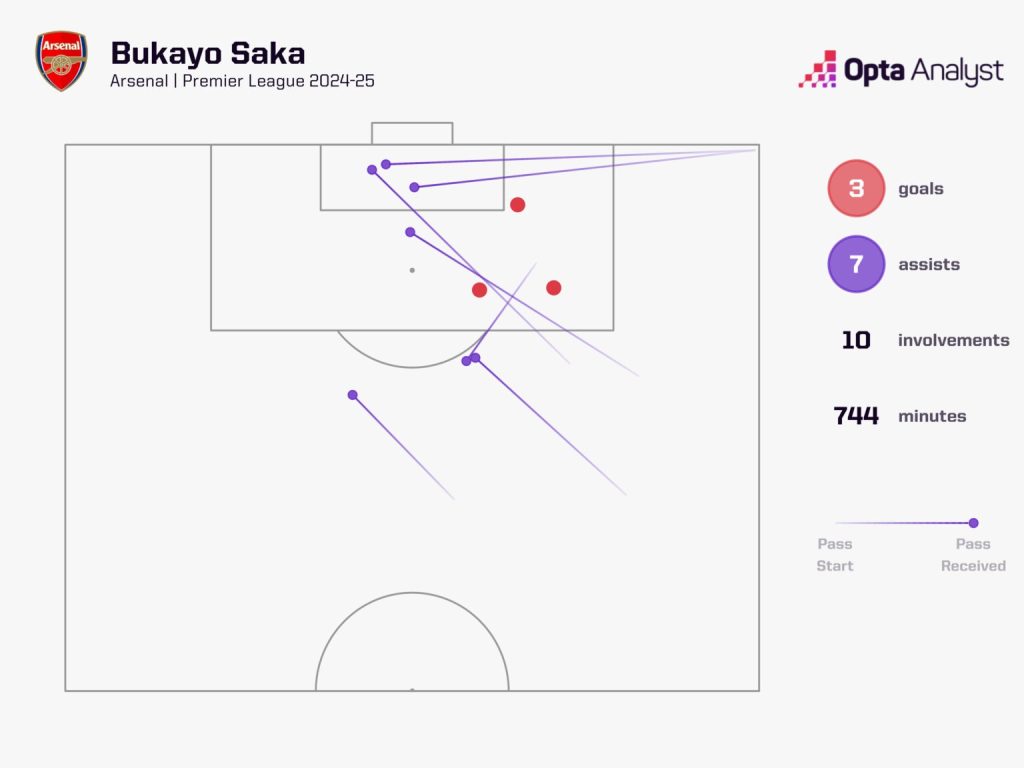
With several key attacking players either sidelined by injury or out of form, Arsenal’s dependence on Saka has become a real concern.
When there are other attacking threats to draw defenders’ attention, Saka becomes an invaluable asset. However, without those supporting players or when they’re not performing to their best, it becomes much harder for him to make an impact on games.
The Growing Imbalance in Arsenal’s Attack Due to Ødegaard’s Absence
Saka has been one of the players most affected by Ødegaard’s absence. Last season, in the Premier League, Ødegaard was the player who passed to Saka the most (322 times), more than any other combination of non-defenders, except for Manchester City’s Mateo Kovacic and Rodri. These numbers don’t even account for the quality of Ødegaard’s passes or how they helped Saka find space. This season, Thomas Partey has taken over as the main passer to Saka, but he is operating from deeper positions than Ødegaard would, which affects their connection.
At the same time, with Gabriel Martinelli not finding his best form on the left wing, the pressure on Saka has increased. In their loss to Inter, it was clear that Arsenal’s plan was simply to get the ball to Saka and hope he could create something, as Martinelli was ineffective on the opposite flank.
Arsenal’s attacking issues have been simmering for a few weeks now. They’ve failed to score in three of their last six matches and have particularly struggled to break down teams in open play. In the Premier League, they’ve managed just 13 goals from open play in 10 games this season.
At San Siro, their lack of ideas was evident as they resorted to crossing the ball repeatedly, finishing with 46 crosses overall. Of these, 33 came from open play, marking their second-highest total under Arteta in 248 matches (excluding extra-time), behind the 37 crosses they attempted in a 3-2 win over Bournemouth in March 2023, when they desperately attacked a low block until finding a late winner.
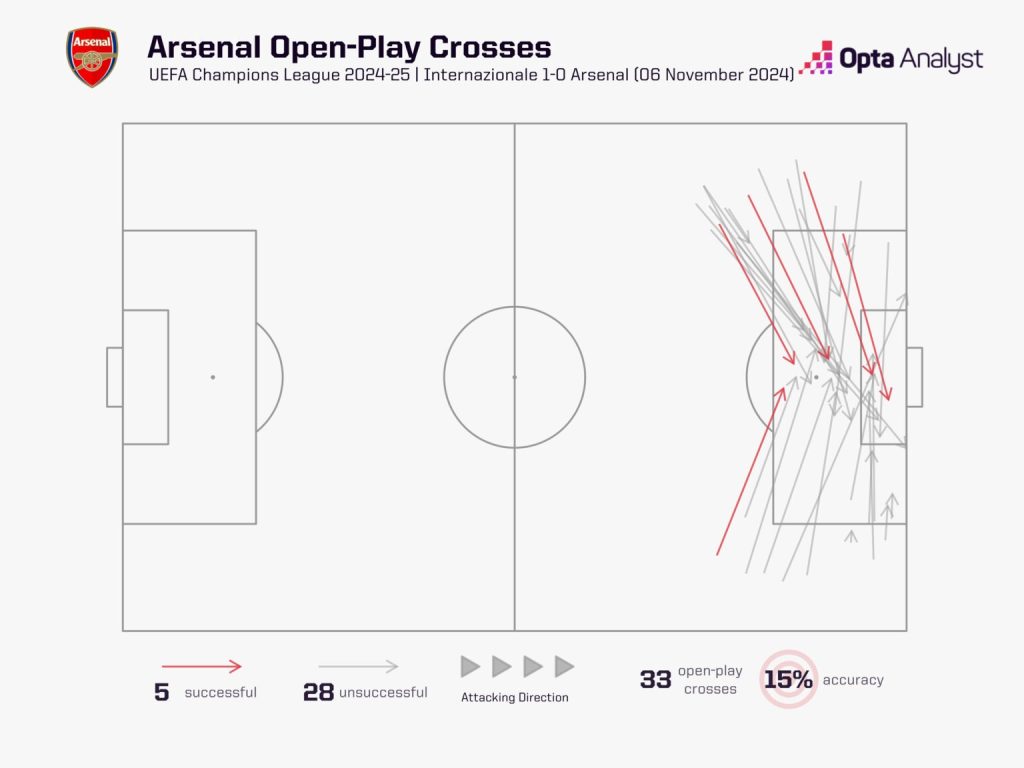
Crossing isn’t inherently a negative tactic, especially against a team like Inter, who sat deep and invited pressure. However, it was clear on Wednesday that this approach wasn’t working, and it was concerning that Arsenal seemed to have no other ideas.
As crosses continued to fly into the box, it was hard not to recall Arteta’s words following a November 2020 defeat to Wolves, when Arsenal had attempted 33 crosses without success.
“I think it is the first time in the Premier League that we put 33 crosses in,” Arteta had said. “I am telling you that if we do that more consistently, we are going to score more goals. If we put the bodies we had in certain moments in the box, it’s maths, pure maths, and it will happen.” At the time, his comments were met with ridicule, and many believed that this approach was something Arteta’s revamped, title-contending Arsenal had moved on from.
Ødegaard’s Potential Return: A Ray of Hope
However, the performance against Inter may not be all that surprising given Ødegaard’s absence. Since the start of last season, Arsenal have averaged 9.3 crosses per game in open play when Ødegaard is available, compared to 13.6 per game when he’s absent. That’s a 46.2% increase in crosses when the Norwegian playmaker is missing.
This increase in crossing can largely be attributed to Ødegaard’s role in getting on the ball in central areas, between the lines, which allows Arsenal to attack through the middle. Last season, Ødegaard averaged more touches in ‘Zone 14’—the area just outside the opposition’s penalty box—than any other Arsenal player who played over 1,000 minutes, with 5.3 touches per 90 minutes.
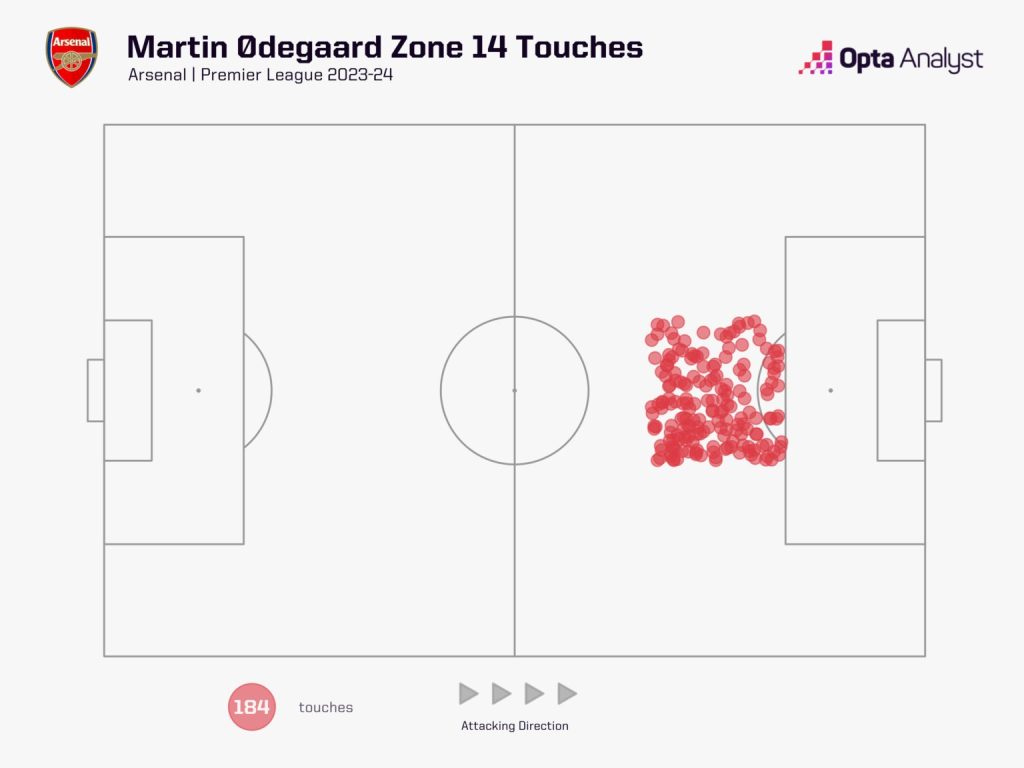
This season, with Ødegaard absent, Arsenal’s most frequent players in the crucial ‘Zone 14’ are Thomas Partey and Declan Rice—both more defensively oriented midfielders. Yet, their involvement is limited, averaging just 3.8 and 2.9 touches per 90 minutes, respectively, among players who’ve featured in at least 200 minutes.
Additionally, Arsenal have needed more from Martinelli on the left wing to alleviate some of the pressure on Saka. However, Martinelli has yet to find his best form, leading to an even greater reliance on Saka to carry the attacking burden.
Last season, Arsenal generated 43.0% of their chances from the right side of the pitch, the highest proportion in the Premier League, highlighting just how central Saka was to their offensive play.
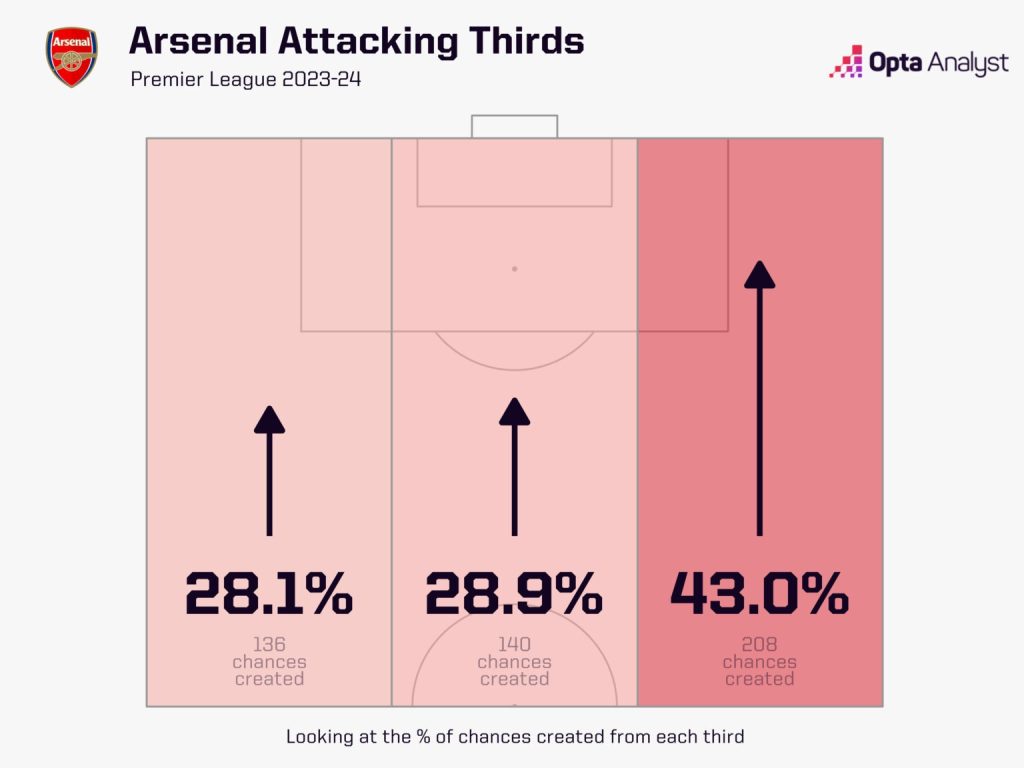
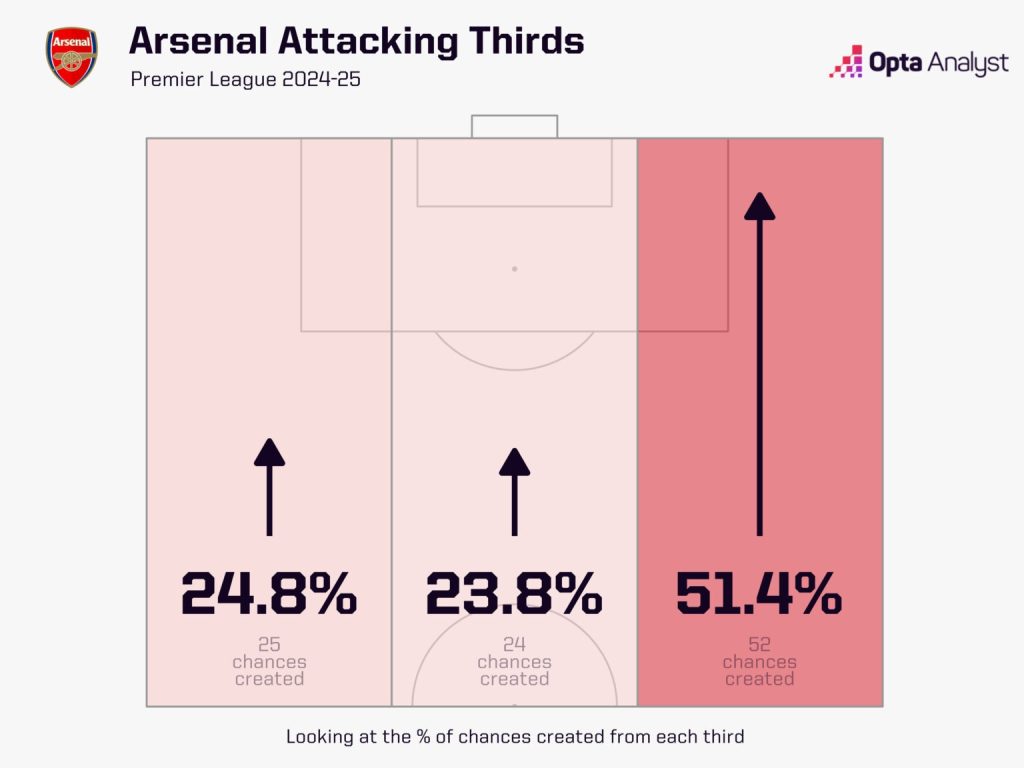
This season, Arsenal’s imbalance has become even more pronounced, with 51.4% of their chances created coming down the right side, making it the highest proportion in the Premier League for the 2024-25 season by a significant margin.
Relying on a player as talented and dangerous as Saka hasn’t been a major issue in recent years, especially as Arteta has shaped Arsenal into genuine title contenders. However, with other players not stepping up to share the attacking load, the team is feeling the strain. Ødegaard’s return couldn’t come at a more crucial time.
Read More: Premier League 2024/25: Chelsea vs Arsenal – Match Preview
Why is Arsenal so reliant on Saka?
Ødegaard’s absence and underperforming attackers have left Saka carrying the offensive load.
How has Ødegaard’s absence impacted Arsenal?
The team has shifted to more crosses, increasing pressure on Saka.
What’s Ødegaard’s role in Arsenal’s attack?
He links play centrally, creating key passes for Saka and others.
Why is Ødegaard’s return crucial?
His return will ease Saka’s load and restore balance to the attack.

